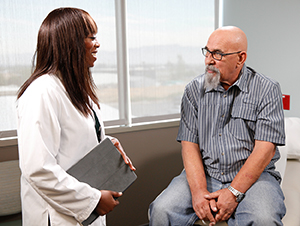Shingles (Herpes Zoster)
 |
| Talk to your healthcare provider about the shingles vaccine. |
Shingles is also called herpes zoster. It's a painful skin rash caused by the herpes zoster virus. This is the same virus that causes chickenpox. After a person has chickenpox, the virus stays inactive in the nerve cells. Years later, the virus can become active again and travel along the nerve to the skin. Most people have shingles only once. But it's possible to have it more than once.
Who is at risk for shingles?
Anyone who has ever had chickenpox can get shingles. But your risk is greater if you:
-
Are age 50 or older
-
Have an illness that weakens your immune system, such as HIV/AIDS
-
Have cancer, especially Hodgkin disease or lymphoma
-
Take medicines that weaken your immune system
What are the symptoms of shingles?
-
The first sign of shingles is often pain, burning, tingling, or itching on one part of your face or body. You may also feel as if you have the flu, with fever and chills.
-
A red rash with small blisters appears in a few days. The rash may look as follows:
-
The blisters can occur anywhere, but they’re most common on the back, chest, or belly (abdomen).
-
They usually appear on only one side of the body, spreading along the nerve pathway where the virus is reactivating.
-
The rash can also form around an eye, along one side of the face or neck, or in the mouth.
-
In a few people, often those with a weak immune system, shingles appear on more than one part of the body at once.
-
After a few days, the blisters become dry and form a crust. The crust falls off in days to weeks. The blisters generally don't leave scars. But they can in severe cases. Or if someone has a weak immune system.
How is shingles treated?
For most people, shingles heals on its own in a few days or weeks. But treatment is advised to help ease pain, speed healing, and reduce the risk for complications. Antiviral medicines are most often only prescribed if you are seen by a healthcare provider within the first 72 hours of having the rash. But antiviral medicines may be prescribed even after 72 hours if your immune system is weak. Or if the infection is extensive, severe, or isn't going away. To reduce symptoms:
-
Apply ice packs or cool compresses, or soak in a cool bath. To make an ice pack, use a bag of frozen vegetables or put ice cubes in a plastic bag that seals at the top. Wrap the bag in a clean, thin towel or cloth. Never put ice or an ice pack directly on the skin.
-
Use calamine lotion to calm itchy skin.
-
Ask your provider about over-the-counter pain relievers. If your pain is severe, your provider may prescribe stronger pain medicines.
What are possible complications of shingles?
Shingles often goes away with no lasting effects. But some people have complications during or after the infection comes out:
-
Postherpetic neuralgia. This is the most common complication. It's more likely as people age, especially after age 60. It's nerve pain at the place where the rash used to be. It can range from mild to severe. It can last for only a few days. Or it can last for months or even years after you have had shingles. Antiviral medicines given during the first 72 hours of the rash can reduce the chance of postherpetic neuralgia. Other medicines can help ease the pain and improve quality of life.
-
Bacterial infection. Shingles blisters may get infected with bacteria. Depending on the severity of the infection, topical, oral or IV (intravenous) antibiotic medicine is used to treat the infection.
-
Eye problems. If you have shingles on the face, see your healthcare provider right away. Shingles can cause serious problems with vision, and even blindness.
In very rare cases, shingles can also lead to pneumonia, hearing problems, brain inflammation, or even death.
When to get medical care
Call your healthcare provider if you have any of these:
-
New symptoms or symptoms that don’t go away with treatment
-
A rash or blisters near your eye
-
More drainage, fever, or rash after treatment
-
Severe pain that doesn’t go away
How can shingles be prevented?
You can only get shingles if you have had chickenpox in the past. Someone who never had chickenpox can get the virus from you. But instead of have shingles, the person may get chickenpox. Until your blisters form scabs, don't have any contact with others, especially the following:
-
Pregnant women who have never had chickenpox or the vaccine
-
Babies who were born early (premature) or who had low weight at birth
-
People with weak immune systems. This includes people getting chemotherapy for cancer, people who have had organ transplants, and people with HIV infections. The risk is higher if you've never had chickenpox.
The shingles vaccine
The recombinant zoster vaccine (RZV) shingles vaccine can help prevent shingles or make it less painful.
You should get the RZV shingles vaccine if you are healthy and age 50 or older, even if you've had shingles in the past. Two shots of the RZV vaccine are needed. You should get the second RZV shot 2 to 6 months after the first. The vaccine makes it less likely that you will develop shingles. If you do develop shingles, your symptoms will likely be milder than if you hadn’t been vaccinated. RZV is also advised even if you had the older shingles vaccine (zoster live vaccine, ZVL) in the past. That's because the RZV vaccine works better and protects you from shingles longer.
Talk with your healthcare provider about the best time to get vaccinated.